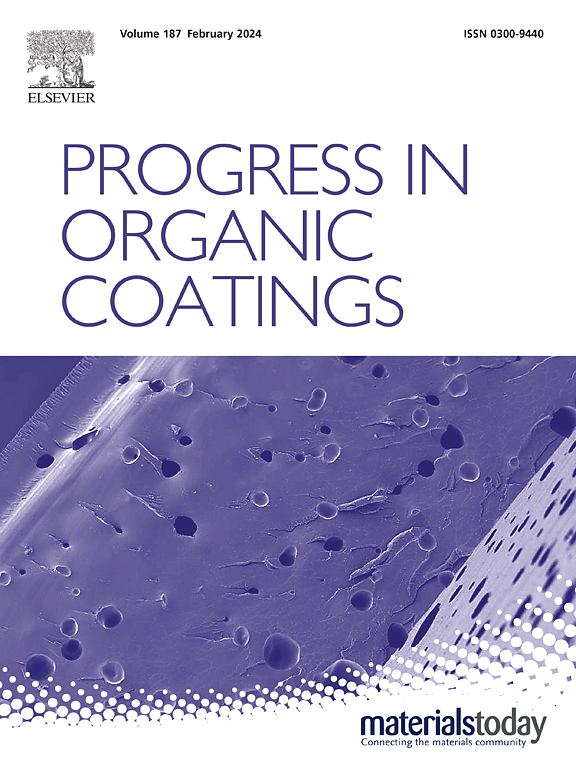Preparation and properties of core-shell self-matting waterborne polyurethane acrylate
IF 6.5
2区 材料科学
Q1 CHEMISTRY, APPLIED
引用次数: 0
Abstract
In order to solve the problems of low density and high brittleness prevailing in traditional matte materials with added matting agents. Herein, a series of self-matting waterborne polyurethane acrylate emulsions (SMWPUA) with rough surfaces, low gloss, and core-shell structures were synthesized by varying the mass ratio of added acrylate monomers using a double-bond capped waterborne polyurethane (WPU) and a polyacrylate as the substrate using the core-shell emulsion polymerization method. Successful synthesis of resins containing core-shell structures demonstrated by Fourier infrared spectroscopy (FTIR), X-ray photoelectron spectroscopy and scanning electron microscope (SEM). Tests such as atomicforce microscopy (AFM) showed that the synthesized emulsions were able to have a good matting effect, which was attributed to the increase in surface roughness and the increase in particle size. Emulsion particle size test was used to explore the variation of emulsion particle size. The thermal stability and hardness changes of SMWPUA and WPU were explored by TGA test and pencil hardness test. The results showed that with the increase of hard acrylate monomer content of SMWPUA, the surface gloss of the coating film was lower, the surface roughness of the cured film was larger, the glass transition temperature was increased, and the emulsion particle size was reduced. SMWPUA has better thermal stability and hardness than WPU.

求助全文
约1分钟内获得全文
求助全文
来源期刊

Progress in Organic Coatings
工程技术-材料科学:膜
CiteScore
11.40
自引率
15.20%
发文量
577
审稿时长
48 days
期刊介绍:
The aim of this international journal is to analyse and publicise the progress and current state of knowledge in the field of organic coatings and related materials. The Editors and the Editorial Board members will solicit both review and research papers from academic and industrial scientists who are actively engaged in research and development or, in the case of review papers, have extensive experience in the subject to be reviewed. Unsolicited manuscripts will be accepted if they meet the journal''s requirements. The journal publishes papers dealing with such subjects as:
• Chemical, physical and technological properties of organic coatings and related materials
• Problems and methods of preparation, manufacture and application of these materials
• Performance, testing and analysis.
文献相关原料
公司名称
产品信息
阿拉丁
potassium persulfate (KPS)
阿拉丁
n-butyl acrylate (n-BA)
阿拉丁
methyl methacrylate (MMA)
阿拉丁
hydroxyethyl acrylate (HEA)
阿拉丁
N,N'-dimethylformamide (DMF)
阿拉丁
trimethylolpropane (TMP)
阿拉丁
dimethylolpropionic acid (DMPA)
 求助内容:
求助内容: 应助结果提醒方式:
应助结果提醒方式:


